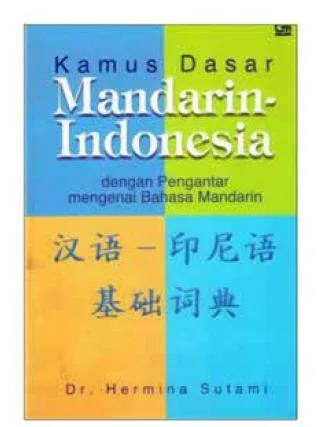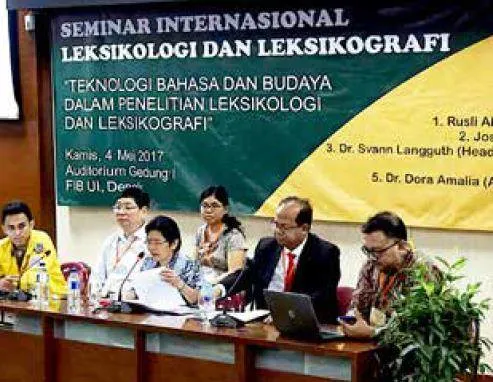印度尼西亚汉语教学的演变与现状
2024-01-01何米娜黄世友



印度尼西亚(下文简称“印尼”)的汉语教学历史悠久,但发展并非一帆风顺,经历了多次起伏。今年恰逢孔子学院创立20周年,在此我们通过本文一起回顾印尼汉语教学的历史,并探讨其发展现状。
The history of Chinese language teachingin Indonesia is both long and rich, though itsdevelopment has faced ups and downs over the years.As we celebrate the 20th anniversary of the foundingof the Confucius Institute, this article reflects on thejourney of Chinese language education in Indonesiaand explores its current state of development.
一、印尼汉语教学的发展
1. Development of ChineseLanguage Teaching in Indonesia
1998年5月之后, 汉语教学在印尼经历了一次显著而深远的复兴。经过改革后的汉语教学可被形象地比喻为雨季迅速生长的蘑菇。这一比喻不仅捕捉到汉语教学在印尼的迅速扩张,也反映了其在社会各阶层和地区中的广泛传播。这种教学趋势的转变体现了印尼社会对于汉语教学价值的重新认识和评估。这一变革为印尼社会的文化交流和人才培养提供了新的机遇,同时也为汉语教学的国际推广提供了宝贵的经验和启示。
After May 1998, Chinese language teachingexperienced a remarkable revival in Indonesia. Thisrapid expansion can be compared to mushroomssprouting after a rainstorm, illustrating both thespeed and scale of its growth across various regionsand social strata. This surge in teaching reflectsa renewed appreciation for the value of Chineselanguage education in Indonesian society. Thetransformation has created new opportunities forcultural exchange and talent development, offeringvaluable insights for the global promotion of Chineselanguage education.
作为一门外语,汉语在印尼的发展轨迹与其他外语,如英语、荷兰语、阿拉伯语、德语、法语、日语、韩语等相比,呈现出独特之处。在语言学和教学的视角下,这些语言在印尼的发展被认为具有相对稳定性和连续性,而汉语的发展则显示出不同寻常的动态性和变化性。早在1947年,印尼大学人文学院便已设立四个学科系,即印尼文系、法文系、汉学系以及人类系。不过这时的汉学在印尼教学体系中尚处于起步阶段。
Compared to other foreign languages likeEnglish, Dutch, Arabic, German, French, Japanese,and Korean, the trajectory of Chinese as a foreignlanguage in Indonesia has followed a uniquepath. While these other languages developed in arelatively stable and continuous manner, Chineselanguage education has been marked by dynamismand variability. As early as 1947, the Faculty ofHumanities at Universitas Indonesia establishedfour departments: Indonesian, French, Sinology, and Anthropology. At that time, however, Chinese studieswere still in their early stages within Indonesia’seducational system.
随着时间的推移,到了1967年末,印尼大学在学院结构调整中成立了东亚学系,包括中文系(原汉学系)和日文系,这标志着汉学在印尼开始受到更多的关注和重视。虽然在1973年之前,东亚学系的学生人数极为有限,仅有七位教师和五位学生参与其中,但这些师生的坚持和努力为汉学研究的未来发展奠定了坚实的基础。从1977年开始,中文系的名称再次变更为汉学系。这一变化与全球对中国文化和语言认识的提升,以及印尼与中国之间交流的加深有着密切的联系。更名后的汉学系见证了印尼各界对汉学研究兴趣的显著增加。
By the end of 1967, the University of Indonesiarestructured its academic departments andestablished the Department of East Asian Studies,which included both Chinese and Japanese studies.This marked a significant turning point, as Chinesestudies began to gain more attention in Indonesia.Although the department had only a small number ofstudents before 1973 — with just seven teachers andfive students — the dedication of these early scholarslaid a strong foundation for the future of the researchin Sinology. In 1977, the department was officiallyrenamed the Department of Chinese Literature,reflecting the growing global interest in Chineseculture and the deepening ties between Indonesiaand China. This renaming led to a surge in interest inSinology studies from various sectors of Indonesiansociety.
此外,1986年,一所私立大学——达尔玛佩萨达大学也成立了中文系。这表明,在印尼高等教学领域,汉语已经有了很高的地位。不过,这一时期的汉语教学资源仍然稀缺,可供选择的汉语教材和参考书籍非常有限,很难满足汉语教学的需求。其次,教师可利用的资源非常有限,汉语教师很少有机会到中国深造留学。因此,在印尼汉语教学的早期阶段,许多汉语教师还无法自如地运用汉语进行交流。此外,汉语教师还面临着专业培训机会匮乏的挑战。
In 1986, Darma Pursada University, a privateinstitution, established its own Chinese LanguageDepartment, signaling that Chinese had alreadygained a significant foothold in Indonesia’s highereducation system. However, during this period, therewere still considerable challenges in terms of teachingresources. The availability of Chinese textbooks andreference materials was extremely limited, makingit difficult to meet the demands of Chinese languageeducation. Moreover, there were few opportunitiesfor Chinese teachers to receive further training inChina. As a result, in the early stages of Chineselanguage instruction in Indonesia, many teacherswere not yet fluent in using Chinese as a mediumof communication. Professional developmentopportunities for Chinese language teachers werealso scarce.
孔子学院的成立,为印尼汉语教学的发展带来了极大的转机。2009年,孔子学院采取了一项重要措施,向一批在印尼学习汉语的学生提供了前往中国攻读汉语国际教育专业硕士学位的奖学金,并在北京举行了隆重的开学典礼。这个专业后来成功培养出了许多在印尼从事汉语教学工作的优秀教师,他们为印尼的汉语教学事业作出了巨大贡献。
The establishment of Confucius Institutesmarked a major turning point in the development ofChinese language education in Indonesia. In 2009,the Confucius Institute made a significaek+8KyLN7lI0cq/g5YQevA==nt moveby offering scholarships to a group of Indonesianstudents studying Chinese, allowing them to pursuemaster’s degrees in Teaching Chinese to Speakersof Other Languages (TCSOL) in China. A grandceremony was held in Beijing to celebrate thismilestone. This program successfully trained manyoutstanding teachers, who have since played a keyrole in advancing Chinese language education inIndonesia.
2001年,印尼雅加达的阿拉扎大学开设了专科汉语学习课程,在汉语教学领域迈出了具有里程碑意义的一步。这一举措不仅为汉语教学在印尼的发展奠定了基础,也标志着该校对汉语教学的重视和承诺。随后,在2005年,阿拉扎大学进一步扩展了汉语教学的深度与广度,设立了本科汉语课程。这一发展标志着汉语教学在学术层面的显著提升,为学生提供了更高层次的汉语学习机会。在接下来的几年中,印尼多个城市的大学相继建立了中文系。这些中文系的建立不仅扩大了汉语教学的地域分布,也促进了汉语教学的普及与深入。这些大学院系汇聚成了一个名为“印尼高校中文系协会”(APSMI)的组织。APSMI致力于协调和推动印尼汉语教学的发展,通过其会员单位的共同努力,为汉语教学在印尼的繁荣作出了重要贡献。
In 2001, University Al-Azhar Indonesia (UAI),located in the capital Jakarta, made a groundbreakingcontribution to Chinese language education bylaunching a specialized Chinese language program.This initiative laid the groundwork for the futuregrowth of Chinese language teaching in Indonesiaand demonstrated the university’s commitmentto this field. In 2005, UAI expanded its efforts byoffering a bachelor’s degree in Chinese, markinga significant academic milestone and providingstudents with more advanced opportunities to studythe language. Over the following years, universitiesin multiple cities across Indonesia established theirown Chinese language departments, extending thegeographical reach of Chinese language educationand enhancing its popularity. These programseventually led to the formation of the Association ofIndonesian Mandarin Study Programs (APSMI), anetwork dedicated to coordinating and promotingChinese language education across Indonesia.Through their collective efforts, APSMI has madesignificant contributions to the flourishing of Chineselanguage teaching in the country.
截至2022年,APSMI的会员数量已达到29个,涵盖了印尼各个大学的中文系。这一数字的增长反映了印尼汉语教学的蓬勃发展,也显示了汉语教学在印尼的广泛影响力。值得注意的是,APSMI的会员单位在教学层次上呈现出多样化的特点,不仅提供本科水平的教学,也包括专科的课程。这种多样化的教学层次满足了不同学习者的需求,为不同背景的学生提供了学习汉语的机会。APSMI的会员单位还有一个显著的共同点:无论他们涉及的学科领域是什么,都普遍采用汉语作为教学语言。这种教学方式不仅促进了学习者汉语语言技能的提升,也为他们提供了深入了解中国文化的机会,增强了跨文化交流和理解能力。在这29个会员单位中,有四个单位是高等教学学历等级,而其余25个单位是高等教学大学等级。这一分布显示了APSMI会员单位在教学层次上的广泛覆盖,以及对不同教学阶段汉语学习者的支持。这种多层次、多级别的教学体系为印尼汉语教学的发展提供了坚实的基础,也为印尼学生提供了更加丰富和多样化的学习选择。APSMI会员的分布如下:
As of 2022, APSMI had expanded to include29 member institutions, representing Chineselanguage departments across various universitiesin Indonesia. This growth reflects the rapidexpansion of Chinese language education inthe country and underscores its widespreadinfluence. APSMI member institutions offer awide range of programs, from undergraduate todiploma levels, catering to diverse learners andproviding opportunities for students from variousbackgrounds to study Chinese. A key featureof APSMI members is their extensive use ofChinese as the language of instruction, regardlessof the academic field. This not only improvesstudents’ Chinese language proficiency but alsodeepens their understanding of Chinese culture,fostering greater cross-cultural communicationand appreciation. Among the 29 members, fouroffer diploma-level programs, while the restprovide university-level degrees. This distributionhighlights APSMI’s commitment to supportingl earners at various educational stages. Byoffering a multi-level, multi-tiered educationalsystem, APSMI lays a strong foundation for thedevelopment of Chinese language teaching inIndonesia, giving students access to a richerand more diverse range of learning options. Thebreakdown of APSMI members is as follows:
由于缺乏关于教学重点的数据,上述映射并不完整。然而,总的来说,我们已经对印尼汉语教学所教授的领域有了一个大致的认识。有几个学习项目已经显示出他们对商务、翻译和旅游汉语课程的关注。然而,在学术论文写作中还需要更加详细地阐述这些发现,并提供更多支持性的证据来支撑这些观点。
Due to limited data on specific teaching focuses,the figure above is incomplete. However, we nowhave a general understanding of the areas emphasizedin Chinese language education in Indonesia.Several programs focus on Chinese about business,translation, and tourism. More detailed analysis ofthe findings, supported by additional evidence, isneeded to substantiate these claims.
2010年11月9日,印尼阿拉扎大学孔子学院在首都雅加达正式成立,这标志着印尼汉语教学事业的进一步发展和深化。2010年到2011年期间,印尼共有六所孔子学院相继成立,分别是阿拉扎大学孔子学院、玛拉拿达基督教大学孔子学院、哈山努丁大学孔子学院、玛琅国立大学孔子学院、泗水国立大学孔子学院和丹戎布拉大学孔子学院。这六所孔子学院的中方合作伙伴依次为福建师范大学、河北师范大学、南昌大学、广西师范大学、华中师范大学和广西民族大学。
On November 9, 2010, the Confucius Instituteat UAI was officially established in Jakarta, markinga significant milestone in the expansion of Chineselanguage education in Indonesia. Apart from UAI,between 2010 and 2011, five more ConfuciusInstitutes were founded at Maranatha ChristianUniversity, Hasanuddin University, State Universityof Malang, State University of Surabaya, andTanjungpura University. Their Chinese partnerinstitutions are Fujian Normal University, HebeiNormal University, Nanchang University, GuangxiNormal University, Central China Normal University,and Guangxi University for Nationalities, respectively.
孔子学院在印尼设立后,发挥了多方面的作用,为提升印尼汉语教学质量作出了显著贡献。首先,孔子学院通过在印尼和中国举办的专业培训活动,为本地汉语教师提供了宝贵的进修机会。这不仅提高了他们的教学技能,也增强了他们对汉语教学的热情。其次,孔子学院为学生策划了一系列丰富多彩的文化交流活动,如“汉语桥”比赛、中国文化周、孔子学院日、汉语日、中国传统节日庆祝等。这些活动不仅丰富了学生的课余生活,也极大地激发了他们对汉语学习的兴趣。此外,孔子学院还向学校提供了汉语教师志愿者和教材资源,这在很大程度上缓解了印尼汉语教学资源的短缺问题,同时也为学生提供了更为丰富和多元的学习资源。这些支持不仅为印尼的汉语教师和学生带来了温暖的鼓励,也加深了中印两国人民之间的友谊。在孔子学院的助力下,印尼的汉语教师和学生得以更快、更准确地掌握汉语技能。
Since their establishment, the Confucius Instituteshave played a pivotal role in improving the quality ofChinese language education in Indonesia. First, theyhave provided valuable professional developmentopportunities for local Chinese language teachers through training programs held both in Indonesiaand China. These initiatives have not only enhancedteachers’ skills but also deepened their enthusiasm forteaching Chinese. Second, the Confucius Instituteshave organized various cultural exchange activities forstudents, such as the “Chinese Bridge” competition,Chinese Culture Week, Confucius Institute Day,Chinese Language Day, and celebrations of traditionalChinese festivals. These activities have enrichedstudents’ extracurricular experiences and sparkedgreater interest in learning Chinese. Moreover, theConfucius Institutes have helped address the shortageof teaching resources by supplying volunteer Chineseteachers and educational materials, easing the resourceconstraints and offering students a more diverse andenriching learning environment. These efforts haveprovided strong support and encouragement to bothteachers and students, while also fostering closer tiesbetween the people of China and Indonesia. With thebacking of the Confucius Institutes, Chinese languagelearners in Indonesia have been able to acquirelanguage skills more quickly and effectively.
二、 当前印尼汉语教学的实践与挑战
2. Current Practices andChallenges of Chinese LanguageTeaching in Indonesia
在印尼,汉语教学在当代教学体系中扮演着举足轻重的角色。其核心目标是培养具备与汉语母语者进行有效口头和书面交流能力的人才,以适应全球化背景下对跨文化交流日益增长的需求。通过汉语教学,学生将能够更好地融入使用汉语的国际社区,增强跨文化沟通和理解的能力。
Chinese language education plays a criticalrole in Indonesia’s modern education system. Itsprimary goal is to equip students with the skillsto communicate fluently in both spoken andwritten Chinese and meet the increasing demandfor intercultural exchange in today’s globalizedworld. By learning Chinese, students enhance theirability to engage with the international community,deepening their cross-cultural understanding andcommunication skills.
此外,汉语教学还旨在培养学生对汉字书籍和其他印刷品的阅读和理解能力。这一点在科学和非科学领域尤为重要,因为无论是在文学、语言教学、经济学还是在社会学等领域,对汉语文献的深入理解和掌握都是不可或缺的。
In addition to language proficiency, Chineselanguage education focuses on helping studentsmaster Chinese characters and comprehend writtenmaterials. This skill is essential not only for personalenrichment but also for academic and professionalpursuits in fields like literature, language teaching,economics, and the social sciences, where a solidgrasp of Chinese is invaluable.
在印尼,汉语和汉语教学的推广和实施,不仅有助于提升国家的教学水平和国际竞争力,还为学生提供了宝贵的语言资源和文化知识,使他们能够在全球化的世界中更好地定位自己,发挥自己的潜力。通过这些教学活动,印尼正在积极构建一个多元化、包容性强的教学体系,为学生打开通往世界的大门,促进文化交流与理解,推动社会的整体进步与发展。
The promotion and expansion of Chineselanguage education in Indonesia contribute notonly to raising national educational standardsand global competitiveness but also to providingstudents with valuable linguistic and culturaltools. These tools enable them to better navigate aglobalized world and open up new opportunities forpersonal success. Through these educational efforts,Indonesia is fostering a diverse and inclusive learningenvironment that encourages cultural exchange,understanding, and overall societal progress.
为了实现这一目标,教学改进工作由国家教学部的初中教学总局和高等教学总局联合中国—印尼研究项目的理论或应用语言学专家共同开展。这些专家将负责制定课程、教学大纲和教材,并承担起教师培训的重任。
Efforts to enhance Chinese language educationare being spearheaded by the Junior and SeniorHigh School Education Bureaus under Indonesia’sMinistry of Education, Culture, Research andTechnology, in collaboration with linguists from theChina-Indonesia Research Project. These expertsare responsible for developing curricula, syllabi,and teaching materials, as well as overseeing theimportant task of teacher training.
在教学体系中,课程、教师和学生构成了一个相互依存和相互作用的三角关系。课程的设计和实施旨在反映学生在特定学科领域的成就和能力,这不仅为学生提供了必要的知识和技能,而且使他们能够在毕业后将所学应用于职场,实现理论与实践的有效结合。而课程的成功实施,以及学生能力的有效培养,又都依赖于知识渊博的教师的支持。这些教师不仅需要具备深厚的专业知识,还应该能够根据专业领域的最新发展和工作场景的具体需求有效地传授这些知识给学生。教师的专业素养和教学能力对于激发学生的学习兴趣、引导他们的学术探索和职业发展具有至关重要的作用。当教师、学生和课程这三个要素之间的相互作用达到最佳状态时,这样的教学环境将促进学生的全面发展,使他们能够在未来的职业生涯中取得成功。
In this educational framework, the curriculum,te a che r s , and s tudent s form a dynam i c ,interconnected system. The curriculum is designedto reflect students’ achievements and competenciesin key subjects, providing them with both knowledgeand practical skills they can use in the workplace aftergraduation and bridging the gap between theoreticallearning and real-world application. However, thesuccess of the curriculum and students relies heavilyon the expertise of teachers, who must stay up to datewith the latest developments in their fields and adjusttheir teaching to meet the evolving demands of theworkplace. Teachers play a pivotal role in ignitingstudents’ passion for learning, guiding their academicjourney, and supporting their career development.When teachers, students, and the curriculum worktogether in harmony, the educational experiencepromotes well-rounded student development,equipping them to succeed in their future endeavors.
三、 印尼汉语教学资源的构建与优化
3. Development and Optimizationof Chinese Language TeachingResources in Indonesia
印尼的汉语教学资源开发与优化可以细分为师资、教材和课程三大核心领域。在师资建设方面,孔子学院的成立显著提升了印尼汉语教师的规模与教学水平。我们还应更加关注教材和课程的完善。印尼政府高度重视汉语教学的进展,并已通过法律条文确立了相关课程标准。这些标准对印尼汉语教材和参考资料的制定产生了深远影响。印尼政府特别强调汉语的使用不仅是为了在特定领域内与中国社会进行交流,更是印尼人身份认同的一部分。因此,在编写教材和参考书籍时,应重视将中国常用词汇纳入其中,并根据不同的应用场景进行分类整理。
The development and optimization of Chineselanguage teaching resources in Indonesia can be groupedinto three key areas: teacher training, textbooks, andcurricula. The establishment of Confucius Instituteshas greatly expanded both the number and quality ofChinese language teachers in the country. However, morefocus is needed on improving the quality of textbooksand curricula. The Indonesian government has placed ahigh priority on advancing Chinese language educationand has set curriculum standards through legislation.These standards have had a significant influence onthe development of Chinese textbooks and referencematerials in Indonesia. Importantly, the governmentstresses that Chinese language instruction is not only forcommunication with Chinese-speaking communitiesbut also serves as part of Indonesia’s cultural identity. As such, it is vital that textbooks and reference materialsinclude commonly used Chinese vocabulary, organizedaccording to real-world situations.
此外,随着科技的蓬勃发展,印尼汉语教学领域的相关要求也在不断发展。在印尼汉语教学中,注重培养学生的批判性思维和创造力。除了知识获取,学生还需要发展社交和软技能。因此,采用新的教学方法鼓励学生独立探索和探究,对于帮助学生为适应现代工作环境做好准备至关重要。目前,在汉语教学中,电子词典和学习软件的使用已经成为不可避免的趋势。教师需要决定学生可以使用哪种词典作为参考工具。同时,教师也需要持续监督学生的使用,以确保他们不过度依赖它们。
With rapid advancements in technology, the needsof Chinese language education in Indonesia are alsoevolving. The current focus extends beyond languageacquisition to fostering students’ critical thinking andcreativity. In addition to gaining knowledge, studentsare expected to develop social and soft skills. This shiftrequires the adoption of new teaching methods thatpromote independent exploration and inquiry. Theuse of digital tools, such as electronic dictionaries andlearning apps, has become an integral part of Chineselanguage instruction. Teachers play a crucial role inguiding and monitoring students on the appropriate useof these tools, ensuring that they are not overly relianton them.
四、 印尼汉语教学面临的主要
4. Key Issues and ImprovementStrategies in Chinese LanguageTeaching in Indonesia
鉴于印尼政府对汉语学习设定了明确的课程标准,准备好符合这些标准的教材和辅助材料显得尤为重要。例如,印尼著名的出版社Gramedia Pustaka Utama 出版了何米娜教授主编的《汉语—印尼语基础词典》。这本词典提供了一个全面的词汇信息框架,涵盖了各个专业领域的词汇,如医学、体育等,为学生提供了宝贵的学习资源。除了以参考书的形式提供特定领域的词汇资源,我们还需要帮助印尼的汉语学习者掌握汉语成语,并通过这些词汇介绍中国文化。
With the Indonesian government establishingclear curriculum standards for Chinese languageeducation, it’s essential to develop textbooks andsupplementary materials that align with theseguidelines. One example is the Kamus DasarMandarin-Indonesia (Basic Chinese-IndonesianDictionary), edited by Professor Hermina Sutami andpublished by Gramedia Pustaka Utama, which offersa comprehensive vocabulary framework coveringfields like medicine and sports. This resource providesvaluable support for students by offering specializedvocabulary. In addition to these resources, it’s equallyimportant to help Indonesian learners grasp Chineseidioms, using them as a gateway to deeper culturalunderstanding.
在印尼,汉语学习者普遍使用的纸质词典主要分为双语词典和释义词典两大类。然而,面对中国社会实际使用的丰富词汇,这些传统词典在帮助学习者全面掌握汉语方面存在局限。为了克服这一难题,汉语分类词典的引入显得尤为关键。例如,苏新春教授主编的《现代汉语分类词典》通过将词汇按照相关领域进行细致分类,不仅满足了印尼政府对汉语教学的高标准要求,而且为教材编写和教学实践提供了宝贵的参考。这种分类法不仅有助于学习者更系统地学习词汇,而且也使得词汇学习更加贴近实际应用场景。此外,为了进一步提高学习者对汉语词汇的深入理解,需要采用能够将单词的含义与印尼本土文化的思维方式联系起来的教学方法。这样,学生才能更深入地掌握词汇。
In Indonesia, students primarily rely on twotypes of dictionaries: bilingual dictionaries andexplanatory dictionaries. However, these traditionalresources often fall short in helping learners fullyunderstand the richness of modern Chinesevocabulary. To address this, introducing categorizedChinese dictionaries is crucial. For example,Professor Su Xinchun’s Modern Chinese ClassifiedDictionary organizes vocabulary into thematiccategories, making it easier for learners to studywords relevant to different fields. This not only alignswith the Indonesian government’s high standardsfor Chinese language education but also provides asolid reference for both textbook development andteaching practices. Categorizing vocabulary helpslearners study more systematically and relate wordsto real-world applications. Additionally, teachingmethods that connect word meanings with thecultural ideas behind them can deepen students’mastery of the language.
与此同时,汉字作为汉语的重要组成部分,其学习同样不容忽视。鉴于学生习惯于使用电子设备输入汉字,他们的汉字书写能力可能会有所下降。因此,将相互关联的汉字进行分类教学,例如,将与自然相关的汉字进行分组,将有助于学生更好地学习汉字,提高书写能力。
Moreover, Chinese characters, a fundamentalaspect of the language, should not be overlooked.With students increasingly using digital devices toinput Chinese characters, handwriting skills are atrisk of declining. Grouping characters thematically,such as organizing those related to nature, canimprove students’ comprehension of the charactersand reinforce their writing abilities.
汉语是一种具有巨大潜力的语言,印尼的汉语教学需要不断探索和创新,通过引入汉语分类词典、采用有效的教学方法以及重视汉字学习等,来提高学习者的语言技能。这将不仅有助于提高印尼汉语学习者在全球化背景下的跨文化交流能力,也为他们的职业发展提供更多的可能性。
Chinese is a language with vast potential, andcontinuous innovation is key to improving Chineselanguage education in Indonesia. By introducingcategorized dictionaries, adopting effective teachingmethods, and placing a stronger emphasis oncharacter learning, students can make significantstrides in their language skills. This will not onlyboost their cross-cultural communication abilitiesin an interconnected world but also open up greaterprofessional opportunities.
